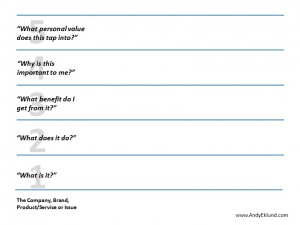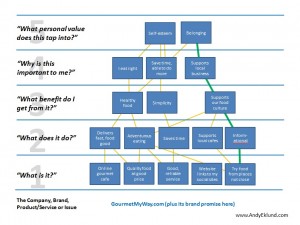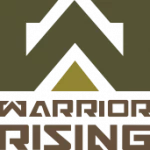
Laddering
Laddering is a brainstorm technique which analyses the benefits and features of a product, service or issue, and connects those attributes to a target audience’s point-of-view and personal values.
More of an interview technique than an exercise to do during a brainstorm, Laddering visually demonstrates how individuals connect a brand’s attributes or benefits to their own subconscious intent or desire about the brand. (You can substitute company, product or service for brand.) Laddering is primarily a positive connection between the brand benefits to one’s personal values, but it can also be an effective tool to map negative connections, such as their personal stake in a brand or a product during a crisis.
Put in a more conversational way, Laddering allows you to get inside the head of your customer by asking simple questions. Creativity comes into play when you 1) ask yourself what insights do the audience’s answers tell you about the brand or its issues, and then 2) brainstorm how you might translate those discoveries into potential ideas for implementation.
(See below the link for the tool, instructions, and a simplified example.)
Laddering: The “Why Method”
Starting broadly and moving to niche, the questions of the Laddering technique are designed for the interviewer to enquire how the respondent subjectively “moves” from benefits of product attributes to the abstract of their unconscious. A simplified conversation might look something like this.
- Respondent: I like A.
- Interviewer: Why do you like A?
- Respondent: Because of B.
- Interviewer. And why B?
- Respondent: Because of C.
- Interviewer: And why C?
The interviewer eventually hears a connection in the person’s response to a particular personal value. By understanding what motivates or inspires a person about a particular topic, the interview might be able to repeat that specific value in marketing or communications to the audience, through messages, engagement and tactics, social and digital media, and visual tone.
How To Conduct The Interviews
Laddering interviews with your customers or similar audience can either be formal or informal, or a mixture of both. Formal research is expensive and time consuming, but it’s also more reliable. For important campaigns or assignments, it’s absolutely worth it. Informal research is a great way to engage a large group of people. In the past, I’ve given all workshop participants a single interview sheet and sent them out to talk to individuals a week prior to the meeting. People bring back with their input, and together in a conference room we plot the Ladder together. It’s a great exercise, and if possible, I like to conduct it prior to a brainstorm.
How to Use It
You can develop the Ladder once you have input from the target audiences.
When I make a Ladder as part of a group exercise, I hang a broad swath of paper on a wall so all of us can easily see it, discuss and adapt it together, and use it as an anchor for brainstorming. If you’re creating one by yourself, it works just fine to use a large sheet of paper on a desk top.
An empty Ladder looks like the chart at right. I’ve also included a real-life but simplified example (below right) from an online gourmet food company that I helped a few years back.
The Ladder works from bottom to top in five horizontal bands corresponding to the five Laddering questions. As much as possible, use the audience’s own words when you answer the questions in the exercise. Don’t wildly paraphrase or make broad assumptions.

Separately, you’ll also need a list of universal values so you can connect the fourth and fifth levels. There are many lists of values. I prefer this list of Universal Values because it’s simplest.
Here are the questions, in interview order.

- “What is it?”
- “What does it do?”
- “What benefit do I get from it?”
- “Why is this important to me?”
- “What personal value(s) does this tap into?”
1. Start at the bottom of the page or chart with Question #1: “What is it?”
Write a concise sentence about the company, brand or product. It must be objective and factual. No opinions. This statement might also be the issue or problem you want to address, written from the POV of the target audience. It might also be a statement about the category or business environment.
In the online food company example, we used the brand proposition statement created by their advertising agency.
2. Go to Question #2: “What does it do?”
Alternative questions: “What’s its purpose?” “What are the benefits or features of the product/service or its attributes?” “How does this make life easier?”
If you’re laddering an issue, try these questions instead: “What consequences, outcomes or affects are happening because of the issue? What’s the rippling or residual effect of this problem?” “How is this making life more complicated, more difficult?”
At this level, the answers are about a specific individual feature, a benefit or attribute. Broad attributes or benefits are OK, but if possible, try to break down general attributes into specific attributes. For example, for a fast food restaurant, we broke down “good customer service” into “good smiles when I walk up to the counter.” Again, keep it objective. No assumptions.
3. Go to the Question #3: “What benefit do I get from it?”
Alternative questions: “What do I get out of it?” “What’s in it for me?” If you’re laddering an issue, “reverse” the questions: “How does this affect me?” “Why is this a problem for me (my family, my neighborhood, etc.)?”
At this level, you begin to tap into the subjective. This is an ideal place to begin to lift specific testimonials, statements, phrases, key words or lingo that the audience uses which show a connection between the bottom level and the personal top level.
4. Go to Question $4: “Why is this important to me?
Alternative questions: “Why do I care about it?” “How does this touch me personally?” “What need do I have that this product satisfies or alleviates?” “What can’t I live without?”
These answers are “selfish” – personal, immediate, intimate. They often touch on emotions (both positive and negative). They should sound altruistic. The important thing is not to judge. It’s alsol easy at this level to question or disbelieve the emotional connection between layers. Don’t. You can go back and re-question the audience, but assume that perceptions are real.
5. Go to the top level. “What personal value does this tap into?”
Unless you’re conducting formal research, this is a question for you and your team in the exercise – it’s not a question to ask the target audience.
From the answers on level 4, discuss how these personal responses connect potentially to personal values. (Definition of “values”: deeply rooted principles which guide what the audience believes and influences their attitudes and behaviours.)
Sometimes we’ve been able to find exact words in the testimonial interviews to help us make that leap. Sometimes it’s an educated guess or a leap of (logical) faith. If we have time and resources, sometimes we go back to the audience and drill deeper with questions which helps us figure out which value is the important one.
Transition to Creative Thinking
From a creativity standpoint, Laddering gives you a new richness of insights to translate into potential ideas.
In the example of the online food website, we discussed the different pathways from bottom to top. As a group, we were most surprised by the connection customers had with the website helping to support local cafes serving unusual cuisines. (Note the broad green line on the right of the chart.)
Where the client had originally wanted to play up all of the global cuisines, the Ladder changed his mind, and decided to make the campaign local. In brainstorming, we began to play with ideas which might bring that “community connection” to life.
To make a long story short, the company eventually created a “Neighborhood Hero” program. Participants could generate points for supporting local neighborhood – even specific restaurants. The points were shown on the home page to all customers (to bait a bit of competitiveness with other customers) as well as demonstrate how the company was doing good works locally. Participants could also use their points as votes in an online auction to choose which grass roots programs they wanted the company to support, working with local councils. Their tally of points/votes were also lodged on the customer’s favourite social media sites, which also helped to spur their friends to try the website. Multiple points also were redeemable for coupons or gift cheques for friends.
Laddering is a broad topic and, I admit, may be confusing. But don’t let it put you off. Of all the creative exercises I’ve used in the past 20 years, Laddering is still one of my favourites, and often the one that brings to life an entirely new idea.
Please tell me what you think below, or send me an email for more information or help in planning a Laddering exercise.
Some other hints, before I forget.
- The blue boxes in my example (a very simplified version of the original) were yellow A5 pages (note cards, about 5×7 inches). You can also use large Post-its, or simply pages cut in half horizontally.
- In a group workshop, I’ve asked people to write their takeaway from the research on a single sheet of paper, then lined them up together along the bottom, then took a moment for a discussion about the one statement we want to “ladder.” I prefer workshop participants to write on coloured pages. They’re easier to see visually everything from across the room.
- Once, for a complex problem, we had five different target audiences who were all key to the campaign’s implementation. We invited a team of ten people, divided into five teams of two. Each team studied their own audience. For the exercise, each team had a different colour paper. It made it easier to see how certain ideas linked to different audiences.
- As a group exercise, it takes about 2-4 hours to facilitate. It works best if the people take an active role in conducting the informal research.
- Laddering often leads directly to brainstorming ideas, so prepare at least another hour afterward for the creative process.
Original document, Laddering
Source:Andyeklund
Adapted for Academy.Warrior rising

